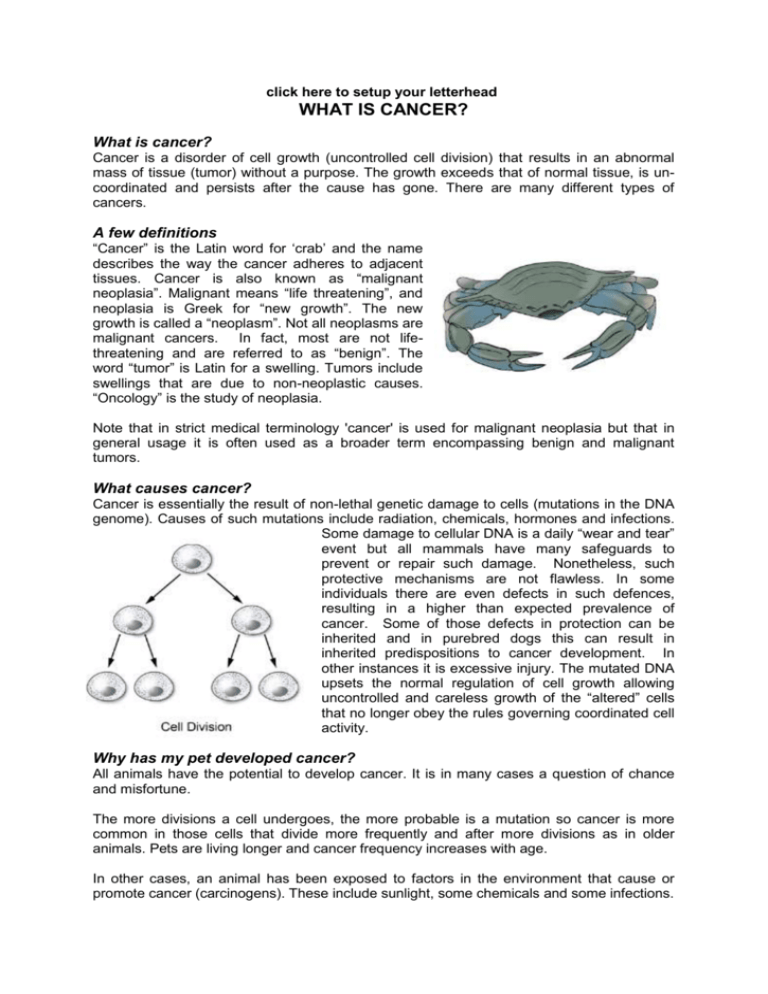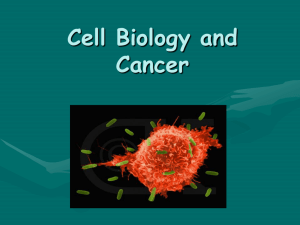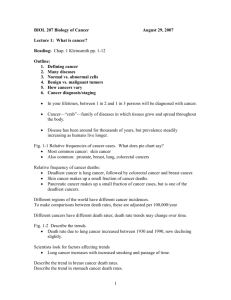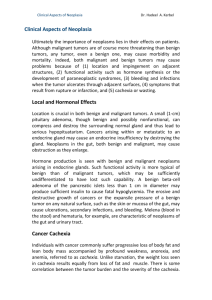What Is Cancer
advertisement

click here to setup your letterhead WHAT IS CANCER? What is cancer? Cancer is a disorder of cell growth (uncontrolled cell division) that results in an abnormal mass of tissue (tumor) without a purpose. The growth exceeds that of normal tissue, is uncoordinated and persists after the cause has gone. There are many different types of cancers. A few definitions “Cancer” is the Latin word for ‘crab’ and the name describes the way the cancer adheres to adjacent tissues. Cancer is also known as “malignant neoplasia”. Malignant means “life threatening”, and neoplasia is Greek for “new growth”. The new growth is called a “neoplasm”. Not all neoplasms are malignant cancers. In fact, most are not lifethreatening and are referred to as “benign”. The word “tumor” is Latin for a swelling. Tumors include swellings that are due to non-neoplastic causes. “Oncology” is the study of neoplasia. Note that in strict medical terminology 'cancer' is used for malignant neoplasia but that in general usage it is often used as a broader term encompassing benign and malignant tumors. What causes cancer? Cancer is essentially the result of non-lethal genetic damage to cells (mutations in the DNA genome). Causes of such mutations include radiation, chemicals, hormones and infections. Some damage to cellular DNA is a daily “wear and tear” event but all mammals have many safeguards to prevent or repair such damage. Nonetheless, such protective mechanisms are not flawless. In some individuals there are even defects in such defences, resulting in a higher than expected prevalence of cancer. Some of those defects in protection can be inherited and in purebred dogs this can result in inherited predispositions to cancer development. In other instances it is excessive injury. The mutated DNA upsets the normal regulation of cell growth allowing uncontrolled and careless growth of the “altered” cells that no longer obey the rules governing coordinated cell activity. Why has my pet developed cancer? All animals have the potential to develop cancer. It is in many cases a question of chance and misfortune. The more divisions a cell undergoes, the more probable is a mutation so cancer is more common in those cells that divide more frequently and after more divisions as in older animals. Pets are living longer and cancer frequency increases with age. In other cases, an animal has been exposed to factors in the environment that cause or promote cancer (carcinogens). These include sunlight, some chemicals and some infections. Some animals have a greater tendency (genetic susceptibility) to cancer. Some breeds have far more cancers than others, often of specific types. A few tumors need hormones to start growing or to enable them to persist. Can my animal catch cancer from another animal or transmit it? For the vast majority of cases the answer to both questions is “No!” Animals can be infected with viruses or other microorganisms some of which cause cancer. Some are infected from their mother before or at birth but infection can also be acquired by contact with other animals. Some can be transmitted through bites of ‘vectors’ such as fleas or ticks. Feline leukemia virus, for example, can cause cancers of the blood and lymphoid system in cats. The virus is occasionally transmitted from an infected queen to her kittens before birth but is more commonly acquired from close contact with infected cats that shed the virus in saliva, urine and feces. If your cat is infected, it can pass the infection to other cats. How does cancer affect my pet? The most obvious effect of most cancers is an enlarging lump, but most lumps are not malignant. This lump may ulcerate, bleed or have physical effects (pressure, displacement, etc.) on the surrounding tissues. Benign cancers only enlarge locally by smooth expansion but malignant cancers may invade regionally with tentacles (i.e. “cancer the crab”). In fact, we use these differences in growth habit to help decide if the cancer is benign or malignant spreading widely through the body. Widespread distribution of a cancer occurs when cancer cells break away from the original tumor and seed in body cavities (such as the pleural cavity of the chest or peritoneal cavity of the abdomen) and when cancer cells invade the blood. The cells may then be carried to distant tissues where the cells lodge and start new tumor masses (metastases). Weight loss due to loss of body fat and muscle is common in malignant cancer and unexplained weight loss can be an important sign. A few tumors induce clinical signs that are not readily explained by local or distant spread of the tumors. These are known as paraneoplastic syndromes. Some syndromes are due to abnormal hormone production by the cancer. (Hormones are internal secretions that pass into the blood and stimulate other organs to action.) Examples of paraneoplastic signs and symptoms include loss of hair, increase or decrease in blood glucose, and increased blood calcium levels. How is cancer diagnosed? Cancer is often suspected from clinical signs (a lump, loss of appetite and energy, loss of weight for example). X-rays may be useful in detecting internal tumors, including metastases. Blood tests can help indicate some tumors. In order to identify most tumor types, it is necessary to obtain a sample of the tumor itself. Surgical invasion may be needed such as needle aspiration, punch biopsy, full excision or exploratory surgery. The simplest approach in many cases is the aspiration (suction removal) of tumor cells with a syringe and needle. It does not require general anesthesia or surgery. Microscopic examination of the cells obtained is called cytology. A more reliable test however, requires surgical removal of a tissue sample under anesthesia. The preparation and microscopic examination of stained sections from the removed tissue is called histopathology. This is done at a specialized laboratory where the slides are examined by a veterinary pathologist. The histopathology report typically includes words that indicate whether a tumor is ‘benign’ (non-spreading, local growth) or ‘malignant’ (capable of spreading to other body sites). Malignancy is often shown by tumor names ending in “carcinoma” or “sarcoma”. These, together with the origin or type of tumor, the grade (degree of resemblance to normal cells) and stage (how far it has spread) indicate how the cancer is likely to behave. The veterinary pathologist usually adds a prognosis (what will probably happen). This may include a prediction about the probability of local recurrence or metastasis (distant spread). Can cancer disappear without treatment? Cancer rarely disappears without treatment but as development is a multi-step process, it may stop at any stage. The body’s immune system can kill cancer cells using mechanisms that specifically target tumor cells that are recognized as “foreign”. These mechanisms include immune system cells such as cytotoxic lymphocytes and macrophages and antibody production. Not all tumors are recognized as foreign and even when they are, the immune system is rarely 100% effective in eliminating the cancer. Rarely, loss of blood supply to a cancer, by pressure on its own supply for example, will result in tumor cell death but the dead tissue will probably need surgical removal. What types of treatment are available? The most common and often most effective treatment is surgical removal of the lump. For lumps that are too big or too numerous to be removed or that are in inaccessible locations, other treatments can be considered. These include drugs (chemotherapy), immunotherapy (specific or non-specific stimulation of the immune system), and radiation. Some of these treatments are only available at specialist centres. New approaches such as gene-based therapies are under development. Chemotherapy or radiation are not suitable for all types of cancer and often have significant side effects. Chemotherapy drugs target differences between the cancer cells and normal cells, but there is a fine margin and inevitably some normal cells are also destroyed. There are many issues to be considered in the decisions on cancer treatment and your veterinarian will discuss these with you. How do I know if the cancer is permanently cured? In many cases, the diagnosis and prognosis indicate there can be a high likelihood of complete cure. Sadly, there are some cases where the diagnosis and prognosis indicate that surgical removal will only give transient relief and the cancer will recur or spread. There are a few tumors that are difficult to predict behaviorally. As in humans, our understanding of cancer in dogs and cats is increasing. Survival rates are improving and many animals are alive and well as “cancer survivors”. This client information sheet is based on material written by Joan Rest, BVSc, PhD, MRCPath, MRCVS. © Copyright 2004 Lifelearn Inc. Used with permission under license. February 16, 2016.











